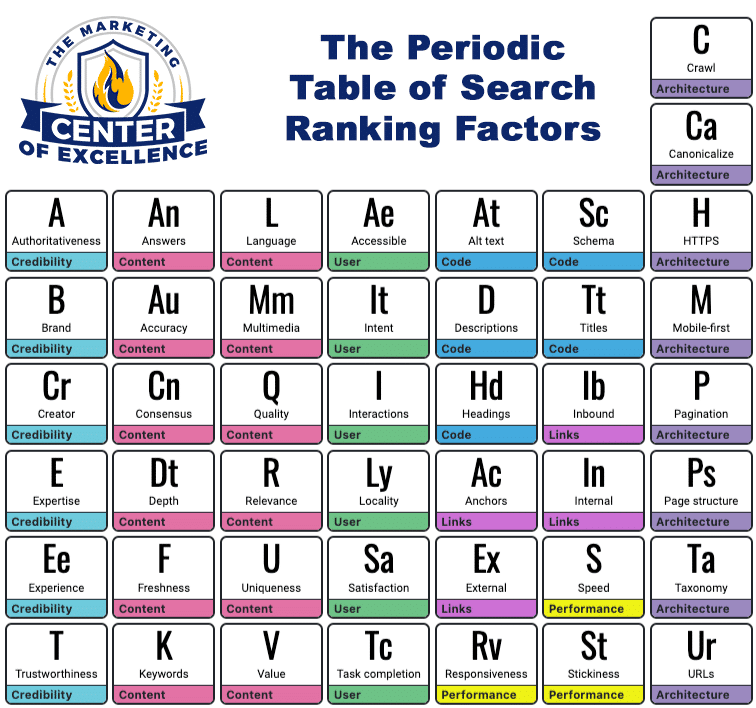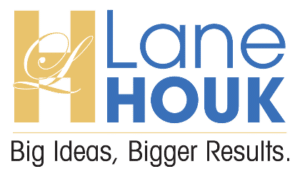Mastering the SEO Ranking Factors for Success
In digital marketing, SEO is a pivotal strategy for enhancing website visibility and driving organic traffic which typically drives the highest quality, highest intent leads to any business. The Periodic Table of SEO Elements has been published by Search Engine Land since 2011 and offers a holistic view of the essential components contributing to a successful SEO strategy.
This new guide I have developed for 2024 delves into each element, with a special focus and spotlight on Content and Credibility for 2024 due to the evolving importance in these two areas. My aim in this guide is to equip you with the knowledge to optimize your website and overall web presence comprehensively using a tried and tested framework for building a winning search engine optimization strategy. Too often, I see agencies looking for the shortcut to rankings, jumping from one new tactic to another. I don’t advise this approach. Instead, look to offer a holistic strategy that encompasses nearly all of what we will discuss here and look/test for the minimum viable solution you can bring to each campaign to get results predictably at least 80% of the time. Then stick with these best practices!
Ok ready? Let’s dive right in…
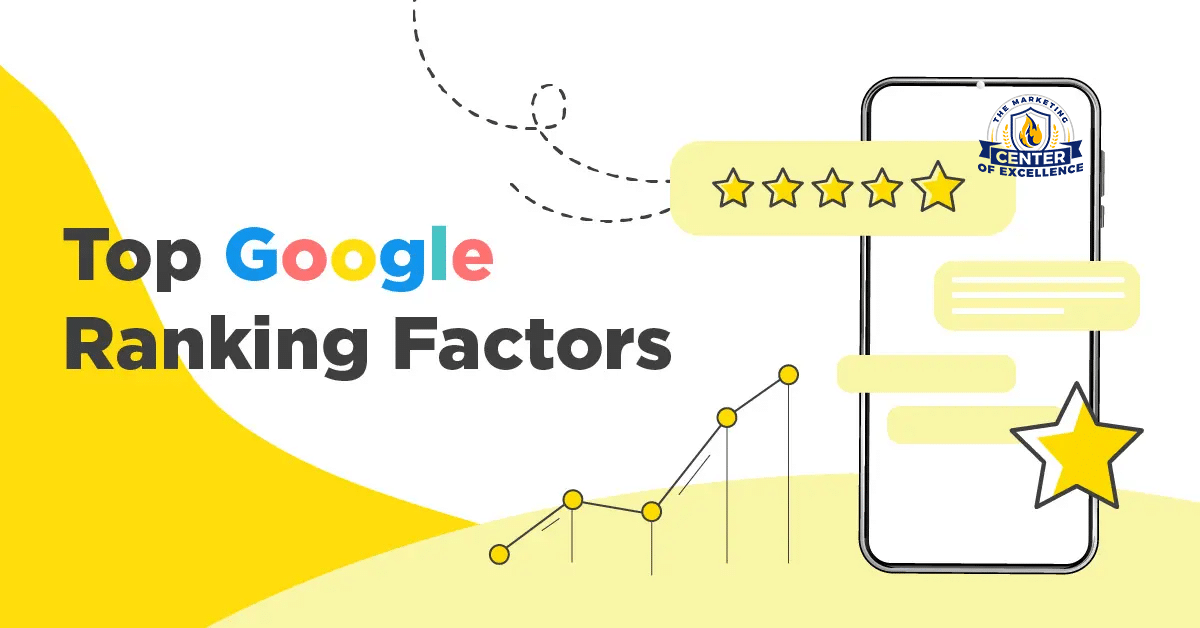
Content: The King of SEO
Content is the foundation of SEO, attracting both users and search engines with high-quality, relevant, and engaging information.
Google’s Helpful Content System is an update to Google’s search algorithm designed to prioritize and reward content that provides a satisfying, helpful experience to users. Launched to ensure that high-quality, informative content created for people, rather than search engines, ranks higher in search results, this system emphasizes the importance of user-focused content. It aims to diminish the visibility of low-quality content that prioritizes SEO tactics over user value.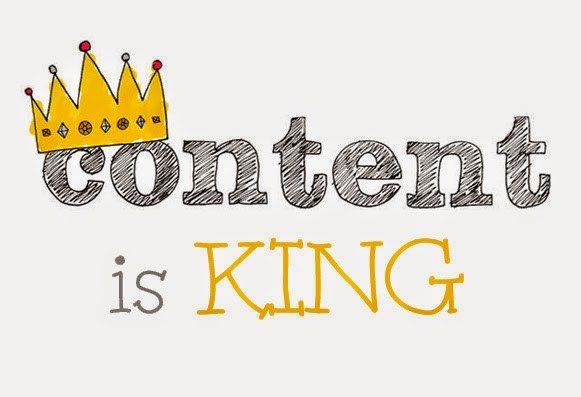
The system evaluates content based on various factors that measure its helpfulness and relevance to real human interests and queries. Websites that consistently produce content designed to help and inform users are more likely to perform well under this system. Conversely, content that seems to have been primarily created to attract search engine traffic, without providing clear, direct, and useful information, may see a decline in search rankings.
It’s important to understand that this HC system is running in multiple parts of the algorithm. SEO agencies must have more than just the basics of this system baked into their content-generation/writing strategy.
Quality (Q)
High-quality content establishes your site as a trustworthy source. Strategy: Focus on addressing your audience’s pain points with well-researched and engaging content including answering PAA (people also ask) questions. Tactic: Conduct original research or interviews and publish your findings. Publish and answer new questions that the market hasn’t asked before.
Keywords (K)
Keywords make your content discoverable. Strategy: Use SEO tools like SearchAtlas.com to find relevant, high-volume keywords and entities that need to be included in your content. Tactic: Incorporate long-tail keywords AND related entities naturally in your content.
Freshness (F)
Updating content keeps it relevant. Strategy: Regularly refresh popular articles and repurpose old blog articles with new info, images, Q&A, etc. Tactic: Use a content calendar for scheduling updates to ensure the freshness signal is always on.
Relevance (R)
Content must match search intent. Strategy: Tailor content to the search intent behind keywords. Tactic: Outline main questions or tasks before writing and always include Q&A in your content with relevant questions and answers.
Depth (Dt)
Comprehensive coverage provides thorough answers. Strategy: Address related subtopics and questions. Tactic: Use “Also Asked” for related questions. Use a tool like AnswerthePublic.com or SearchAtlas.com to find commonly asked questions about a given topic.
Uniqueness (U)
Unique content stands out. Strategy: Offer new perspectives or proprietary data. Tactic: Conduct and share original research. There aren’t any shortcuts to being unique and offering fresh perspectives and topics in a given space or industry but those that put the time and effort into doing so are usually rewarded well by the algorithm.
Answers (An)
Directly answer user queries. Strategy: Structure content with question-based H2 headings. Tactic: Use H3 section heading and bullet points for easy scanning of the answer(s).
Multimedia (Mm)
Multimedia enhances engagement and Google’s algorithm loves to see Mm in content because it knows users love it. Strategy: Incorporate varied multimedia elements like relevant images/pictures and video. Tactic: Embed videos and create infographics. Use AI to do this!
Language (L)
Speak your audience’s language. Strategy: Write in a tone that resonates with your audience. Tactic: Tailor language using audience demographics and great market research tools like SearchAtlas.com to get these data points and insights that can be incorporated into your content/language strategy.
Credibility: Establishing Trust and Authority
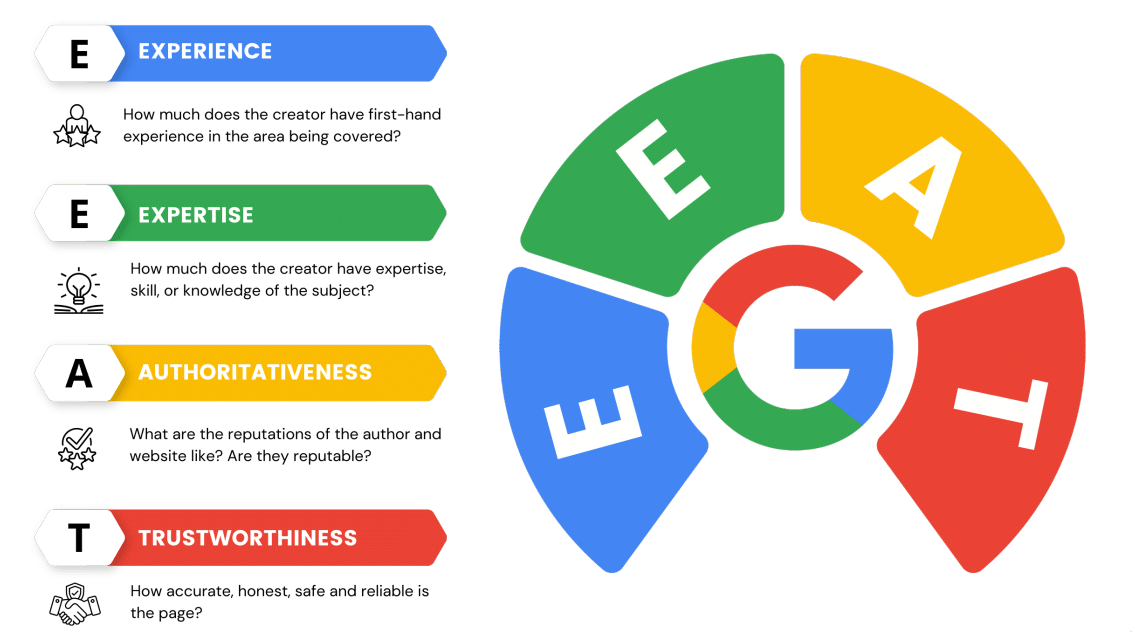
Authoritativeness (A)
Being seen as an authority boosts credibility. Strategy: Showcase expertise through in-depth content, a good author page, and a well-documented LinkedIn profile. Tactic: Leverage a sound digital PR strategy with a smart content strategy for expert positioning using press releases and authoritative news distribution.
Trustworthiness (T)
Accuracy and transparency foster trust. Strategy: Fact-check content and display clear contact information. Tactic: Add an ‘About Us’ page for the company website AND a Team page for the key employees/team members; ensure that each key employee/stakeholder has their own unique bio and author page linked from the Team page.
Brand (B)
A strong brand identity connects with audiences. Strategy: Develop a consistent brand voice. Tactic: Share behind-the-scenes content on social media. Use digital PR to build brand mentions regularly.
Experience (Ee)
Personal experiences demonstrate expertise. Strategy: Share case studies and success stories. Tactic: Publish detailed case studies, education, certifications, licenses, continuing education, and other examples that document experience in an industry or subject matter. Push these updates everywhere… LinkedIn, blog, social media, etc
Architecture: Structuring Your Site for Success
A well-structured website enhances user experience and search engine indexing. This component is highly underrated and misunderstood by many to most. Do not overlook this section. These signals are critical to success in the SERPS and have become more influential in the last 1-2 years than ever before.
Crawl (C)
Making your site easily crawlable improves visibility. Strategy: Use a logical site silo structure. See the taxonomy section below. Tactic: Audit your site for crawl errors and fix them. Use schema on every page to assist the crawler in identifying what the content is about.
Mobile-first (M)
Mobile optimization is essential. Strategy: Design with mobile users in mind. Tactic: Check mobile usability with Google’s tool. Simple but many fail to do this basic stuff.
URLs (Ur)
Clear URLs reflect the content. Strategy: Create descriptive URLs with keywords. Tactic: Use blog categories in your permalink structure and use hyphens to separate words in URLs.
Proper pagination aids navigation. Strategy: Implement pagination correctly. Tactic: Use rel=”next” and rel=”prev” tags.
Page Structure (Ps)
Logical content organization improves SEO. Strategy: Use headings (H2, H3, H4, etc) to structure articles. Tactic: Incorporate keywords and PAA in headings. Use long tail keywords in headings.
Taxonomy (Ta)
Clear categorization helps users find content. Strategy: Use a clear taxonomy that is derived from good market/keyword/entity research using SearchAtlas.com. Tactic: Limit categories and use tags sparingly. Only top-level seed keywords should be used for categories. All blog articles should be assigned to the most relevant category and be sure to use Authorship when publishing blog articles.
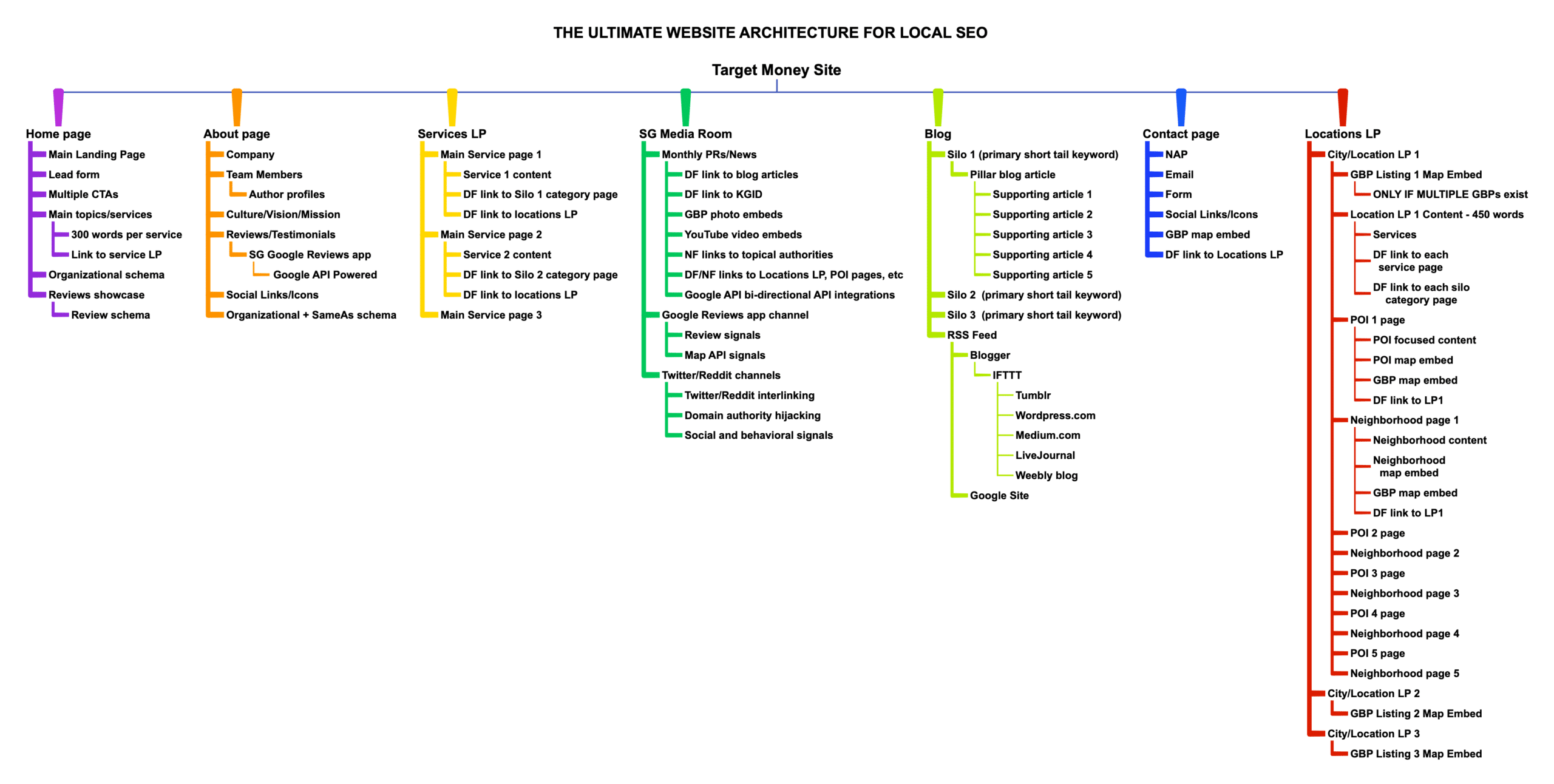
Code: Enhancing SEO Through Technical Excellence
Optimizing your site’s code enhances performance and visibility. This is probably pretty obvious as much as it is straightforward to implement. Use AI to assist you in creating these code-level signals in your pages and posts.
Titles (Tt)
Descriptive titles attract clicks. Strategy: Write unique titles with primary keywords. Tactic: Keep titles under 60 characters.
Descriptions (D)
Meta descriptions act as ad copy. Strategy: Craft compelling descriptions leveraging AI. Tactic: Include a call to action, always!
Headings (Hd)
Headings organize content. Strategy: Use headings for structure. Tactic: Include secondary keywords, long tails, and PAA in subheadings.
Alt Text (At)
Alt text improves image SEO. Strategy: Provide descriptive alt text. Tactic: Describe the image and include keywords. So many people overlook this signal and it is one that Googlebot always gets when crawling a page.
Schema (Sc)
Schema markup enhances SERPs. Strategy: Use schema for detailed information. Tactic: Implement schema for reviews, articles, and products. If it’s a local business, add local business schema to the home page and contact page plus any location pages.
Links: Building Connections
Links establish your site’s authority and help with navigation. Use a SaaS service like Signal Genesys to build links and connections in a leveraged, economical way before you put time and money into manual link building or purchasing links. 
Inbound (Ib)
Quality inbound links boost authority. Strategy: Create shareable content. Tactic: Promote content through outreach.
Internal (In)
Internal links improve engagement. Strategy: Use internal linking wisely. Tactic: Link to important pages with descriptive anchor text.
External (Ex)
Linking out adds value. Strategy: Link to reputable sources. Tactic: Regularly update external links.
User Experience: Meeting Your Audience’s Needs
User experience influences how visitors interact with your site.
Accessibility (Ae)
An accessible site reaches more users. Strategy: Follow WCAG guidelines. Tactic: Ensure keyboard navigability and use high-contrast colors. Use a tool like Accessibe to aid in bringing a website into a basic level of accessibility compliance.
Intent (It)
Content should match user intent. Strategy: Align content with search intent. Tactic: Analyze SERPs for intent clues. Again, SearchAtlas.com is an awesome tool for discovering search intent and mapping that into your content strategy.
Satisfaction (Sa)
Satisfying content keeps users on your site. Strategy: Fully address user queries. Answer the questions the market is asking! Tactic: Include clear calls to action.
Performance: Speed and Efficiency
Site performance affects user experience and rankings.
Speed (S)
Fast loading times are crucial. Strategy: Optimize images and use browser caching. Tactic: Use Google PageSpeed Insights for optimization tips. Be careful of too many scripts running, pixels installed, excessive plugins installed, or large images. These are common culprits in slow-loading sites. Use WPRocket Pro if it’s a WordPress site for caching and performance tweaks that are quantifiable. We use it on all sites.
Responsiveness (Rv)
A responsive site is essential. Strategy: Ensure optimal viewing on all devices. Tactic: Use responsive design techniques.
Implementing these strategies and tactics for each element of the Periodic Table of SEO Elements will comprehensively enhance your website’s SEO, making it more visible, engaging, and authoritative. Remember, SEO is an ongoing process that requires continuous learning and adaptation to the latest trends and algorithm updates.
Conclusion: A Holistic Approach to SEO
SEO is a complex field that requires a comprehensive approach, balancing technical optimization with high-quality content and credible information. By understanding and applying the elements of the Periodic Table of SEO Elements, you can create a robust SEO strategy that enhances your website’s visibility, engages your audience, and builds trust with both users and search engines. Remember, SEO is a continuous process of improvement and adaptation to the ever-changing digital landscape. I hope you have found this guide helpful in understanding how to implement a holistic approach to your SEO strategy!

